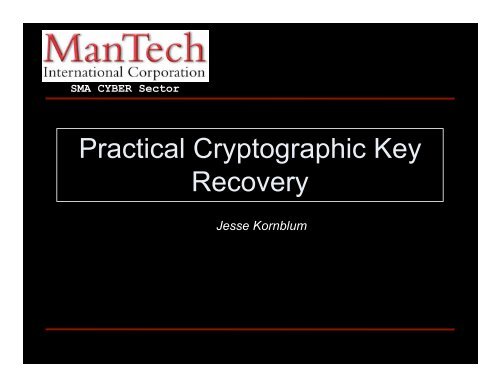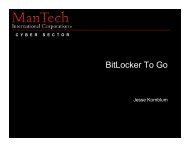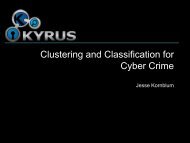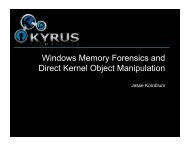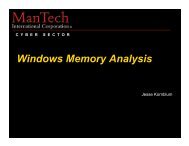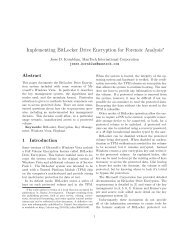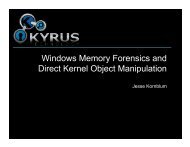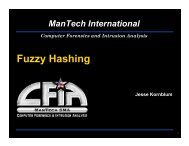Practical Cryptographic Key Recovery - Jesse Kornblum
Practical Cryptographic Key Recovery - Jesse Kornblum
Practical Cryptographic Key Recovery - Jesse Kornblum
- No tags were found...
You also want an ePaper? Increase the reach of your titles
YUMPU automatically turns print PDFs into web optimized ePapers that Google loves.
Current Methods• Brute Force– Try every block of bytes as possible key– "Last resort of the incompetent"– See "Linear Scan" paper by Hargreaves and Chivers– Doesn't work for split keys
Current Methods• <strong>Key</strong> Schedule Search– Better brute force– Really identifying data that is not a key schedule– See "Cold Boot" paper by Halderman et al.
Current Methods• Source code analysis– Requires elbow grease– Can't be automated– Works great– May have to update for each version– See "Volatools" paper by Walters and Petroni, BlackHatFederal 2007
Tool Marks• Marks specific toindividual tools• Associated withphysical forensicsImage courtesy Flickr user grendelkhan, http://flickr.com/photos/grendelkhan/118876699/
TPAM6
<strong>Cryptographic</strong> Tool Marks• Hard to detect the keys themselves– Should be random• Can detect the cryptographic tool itself– Programs– Drivers– Mounted volumes• Can detect the structure surrounding the keys
BitLocker Drive Encryption• I am not aware of any backdoors in BitLocker Drive Encryption• You cannot access a protected volume without the FVEKImage courtesy of the Microsoft Corporation.BitLocker Drive Encryption is a registered trademark of the Microsoft Corporation.
BitLocker Drive Encryption• Good documentation, but not complete– <strong>Key</strong> management systems not described– No implementation of elephant provided• Reverse engineered by Kumar and Kumar– Published paper, linux driver to mount protected volumes– http://www.nvlabs.in/node/9
BitLocker Drive Encryption• Brute Force works– FVEK is in RAM• <strong>Key</strong> schedule search works– Finds several schedules– Two of the keys make up the FVEK• Some assembly required• Source code analysis– Not an option for most of us
BitLocker Tool Marks• BitLocker AES key schedules– Several schedules in memory at any given time– Some bits of FVEK used to generate sector keys– Other bits of FVEK used to encrypt/decrypt data– In default mode, some bits unused
BitLocker Tool Marks• AES key schedules– Encryption and Decryption schedules
BitLocker Tool Marks• Searching for BitLocker AES key schedules in RAM– Overlapped slightly
AlgorithmPool TagAES key in scheduleZeros
BitLocker Tool Marks• 0x0 FVEc pool tag• 0x14 Algorithm ID, must be 0x8000-0x8003• 0x1C Start of first BitLocker AES schedule– AES key must be at start and end of schedule• bytes 0x1C-0x2C and 0x15C-0x16C for 128-bit– Zeros at end of schedule if 128-bit mode• 0x1EC Start of second BitLocker AES schedule– Same rules as above
BitLocker Tool Marks• Not perfect, but good enough• Original• Recovered
Finding Tool Marks• How did we do this?– RTFM• FIPS certifications are great!• Ask developers for help– WinHex– IDA Pro– Checked buildsImage courtesy of User:Icey on Wikipediaand is public domain– Debugging symbols• Always trying to answer:– How does it know where to look?
Performance• Brute Force– O(nm)• <strong>Key</strong> Schedule Search– O(nm)• Source Code– X* + O(n), where X* may be infinite• Toolmarks– X + O(n)
Forensics Tool Marks• Requires as much elbow grease as source code analysis– Often more– Doesn't require the source code• May require updating for each version– TrueCrypt• May be your only option for previously unseen tools
Questions?• Introduction• Targets• Current Methods• Tool Marks• Example - BitLocker• Conclusion
Thank you• Microsoft Corporation for keepingme employed• Kumar and Kumar for their reverseengineering work• AAron Walters for organizing• ManTech International Corporationfor letting me geek out• You for staying!Image courtesy of the Microsoft Corporation.
References• BitLocker Drive Encryption– N. Kumar and V. Kumar, "Bitlocker and Windows Vista",http://www.nvlabs.in/node/9– FIPS Security Policy:http://csrc.nist.gov/groups/STM/cmvp/documents/140-1/140sp/140sp947.pdf• Brute Force Searches– C. Hargeaves and H. Chivers, "<strong>Recovery</strong> of Encryption <strong>Key</strong>sfrom Memory Using a Linear Scan",http://ieeexplore.ieee.org/Xplore/login.jsp?url=/iel5/4529302/4529303/04529504.pdf
References• <strong>Key</strong> Schedule Searching– Cold Boot paper, http://citp.princeton.edu/memory/• Source Code Analysis– AAron Walters and Nick Petroni, Volatools, Volatools:Integrating Volatile Memory Forensics into the DigitalInvestigation Process, http://4tphi.net/fatkit/


